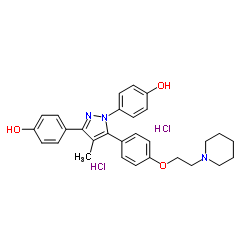MPP dihydrochloride
Modify Date: 2024-08-30 07:57:17

MPP dihydrochloride structure
|
Common Name | MPP dihydrochloride | ||
|---|---|---|---|---|
| CAS Number | 911295-24-4 | Molecular Weight | 542.497 | |
| Density | N/A | Boiling Point | N/A | |
| Molecular Formula | C29H33Cl2N3O3 | Melting Point | N/A | |
| MSDS | Chinese | Flash Point | N/A | |
Use of MPP dihydrochlorideMPP dihydrochloride is a highly selective estrogen receptor alpha (ERα) antagonist. MPP dihydrochloride reduces the ratio of p-ERα/ERα[1]. |
| Name | 4,4'-(4-Methyl-5-{4-[2-(1-piperidinyl)ethoxy]phenyl}-1H-pyrazole- 1,3-diyl)diphenol dihydrochloride |
|---|---|
| Synonym | More Synonyms |
| Description | MPP dihydrochloride is a highly selective estrogen receptor alpha (ERα) antagonist. MPP dihydrochloride reduces the ratio of p-ERα/ERα[1]. |
|---|---|
| Related Catalog | |
| In Vitro | MPP (1, 5, 10, 25, 50 and 100 µM; 24 h) decreases cell viability with an IC50 value of 20.01 µM in RL95-2 cells[1]. MPP dihydrochloride shows antiproliferative activity at a concentration of 10 μM in RL95-2 cells[1]. MPP dihydrochloride (20 µM; 24 h) reduces the phosphorylation of ERα, while it does not alter the phosphorylation of Akt. MPP dihydrochloride reduces the ratio of p-ERα/ERα[1]. Cell Viability Assay[1] Cell Line: RL95-2 endometrium cancer cells Concentration: 1, 5, 10, 25, 50 and 100 µM Incubation Time: 24 hours Result: The treatment with 25 µM, 50 µM and 100 µM for 24 h decreased cell viability significantly. However, cell viability was not significantly changed by MPP dihydrochloride at concentration below 25 µM. Cell Proliferation Assay[1] Cell Line: RL95-2 cell Concentration: 10, 15, 20 and 25 µM Incubation Time: 72 hours Result: Showed antiproliferative activity at a concentration of 10 μM. Western Blot Analysis[1] Cell Line: RL95-2 cell line Concentration: 20 µM Incubation Time: 24 hours Result: Reduced the phosphorylation of ERα, while it did not alter the phosphorylation of Akt. Reduced the ratio of p-ERα/ERα compared to the control group. |
| In Vivo | MPP (Low dose 20 μg/kg body weight or high dose 200 μg/kg body weight) leads to a dose-dependent attenuation of percent prepulse inhibition (PPI)[2]. Animal Model: Male C57BL/6N mice at the age of 9-10 weeks[2] Dosage: Low dose (20 μg/kg body weight) or high dose (200 μg/kg body weight) Administration: Administered subcutaneously (s.c.) injected; injection volume of 5 mL/kg; 60 min before PPI testing Result: Led to a dose-dependent attenuation of percent PPI. Pretreatment with 200 μg/kg reduced the mean percent PPI scores by ~30%. |
| References |
| Molecular Formula | C29H33Cl2N3O3 |
|---|---|
| Molecular Weight | 542.497 |
| Exact Mass | 541.189880 |
| PSA | 70.75000 |
| LogP | 7.33250 |
| 4,4'-(4-Methyl-5-{4-[2-(piperidin-1-yl)ethoxy]phenyl}-1H-pyrazole-1,3-diyl)diphenol dihydrochloride |
| 4,4'-(4-Methyl-5-{4-[2-(1-piperidinyl)ethoxy]phenyl}-1H-pyrazole-1,3-diyl)diphenol dihydrochloride |
| Phenol, 4,4'-[4-methyl-5-[4-[2-(1-piperidinyl)ethoxy]phenyl]-1H-pyrazole-1,3-diyl]bis-, hydrochloride (1:2) |